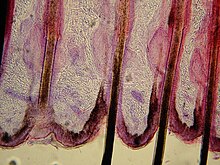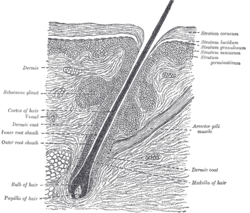Description

Each strand of hair is made up of the medulla, cortex, and cuticle. The innermost region, the medulla, is not always present and is an open, unstructured region. The highly structural and organized cortex, or second of three layers of the hair, is the primary source of mechanical strength and water uptake. The cortex contains melanin, which colors the fiber based on the number, distribution and types of melanin granules. The shape of the follicle determines the shape of the cortex, and the shape of the fiber is related to how straight or curly the hair is. People with straight hair have round hair fibers. Oval and other shaped fibers are generally more wavy or curly. The cuticle is the outer covering. Its complex structure slides as the hair swells and is covered with a single molecular layer of lipid that makes the hair repel water. The diameter of human hair varies from 0.017 to 0.18 millimeters (0.00067 to 0.00709 in). There are two million small, tubular glands and sweat glands that produce watery fluids that cool the body by evaporation. The glands at the opening of the hair produce a fatty secretion that lubricates the hair.
Hair growth begins inside the hair follicle. The only "living" portion of the hair is found in the follicle. The hair that is visible is the hair shaft, which exhibits no biochemical activity and is considered "dead". The base of a hair's root (the "bulb") contains the cells that produce the hair shaft. Other structures of the hair follicle include the oil producing sebaceous gland which lubricates the hair and the arrector pili muscles, which are responsible for causing hairs to stand up. In humans with little body hair, the effect results in goose bumps.
Root of the hair
| Root of the hair | |
|---|---|
 Section of skin, showing the epidermis and dermis; a hair in its follicle; the Arrector pili muscle; sebaceous glands. | |
| Details | |
| Identifiers | |
| Latin | radix pili |
| MeSH | D006197 |
| TA98 | A16.0.00.014 |
| TA2 | 7053 |
| TH | H3.12.00.3.02001 |
| FMA | 53667 |
| Anatomical terminology edit on Wikidata | |
The root of the hair ends in an enlargement, the hair bulb, which is whiter in color and softer in texture than the shaft, and is lodged in a follicular involution of the epidermis called the hair follicle. The bulb of hair consists of fibrous connective tissue, glassy membrane, external root sheath, internal root sheath composed of epithelium stratum (Henle's layer) and granular stratum (Huxley's layer), cuticle, cortex and medulla.
Natural color
All natural hair colors are the result of two types of hair pigments. Both of these pigments are melanin types, produced inside the hair follicle and packed into granules found in the fibers. Eumelanin is the dominant pigment in brown hair and black hair, while pheomelanin is dominant in red hair. Blond hair is the result of having little pigmentation in the hair strand. Gray hair occurs when melanin production decreases or stops, while poliosis is hair (and often the skin to which the hair is attached), typically in spots, that never possessed melanin at all in the first place, or ceased for natural genetic reasons, generally, in the first years of life.
Human hair growth
Hair grows everywhere on the external body except for mucus membranes and glabrous skin, such as that found on the palms of the hands, soles of the feet, and lips.
Hair follows a specific growth cycle with three distinct and concurrent phases: anagen, catagen, and telogen phases; all three occur simultaneously throughout the body. Each has specific characteristics that determine the length of the hair.
The body has different types of hair, including vellus hair and androgenic hair, each with its own type of cellular construction. The different construction gives the hair unique characteristics, serving specific purposes, mainly, warmth and protection.
Texture
Hair exists in a variety of textures. Three main aspects of hair texture are the curl pattern, volume, and consistency. The derivations of hair texture are not fully understood. All mammalian hair is composed of keratin, so the make-up of hair follicles is not the source of varying hair patterns. There are a range of theories pertaining to the curl patterns of hair. Scientists have come to believe that the shape of the hair shaft has an effect on the curliness of the individual's hair. A very round shaft allows for fewer disulfide bonds to be present in the hair strand. This means the bonds present are directly in line with one another, resulting in straight hair.
The flatter the hair shaft becomes, the curlier hair gets, because the shape allows more cysteines to become compacted together resulting in a bent shape that, with every additional disulfide bond, becomes curlier in form. As the hair follicle shape determines curl pattern, the hair follicle size determines thickness. While the circumference of the hair follicle expands, so does the thickness of the hair follicle. An individual's hair volume, as a result, can be thin, normal, or thick. The consistency of hair can almost always be grouped into three categories: fine, medium, and coarse. This trait is determined by the hair follicle volume and the condition of the strand. Fine hair has the smallest circumference, coarse hair has the largest circumference, and medium hair is anywhere between the other two. Coarse hair has a more open cuticle than thin or medium hair causing it to be the most porous.
Classification systems
There are various systems that people use to classify their curl patterns. Being knowledgeable of an individual's hair type is a good start to knowing how to take care of one's hair. There is not just one method to discovering one's hair type. Additionally it is possible, and quite normal to have more than one kind of hair type, for instance having a mixture of both type 3a & 3b curls.
- Andre Walker system
The Andre Walker Hair Typing System is the most widely used system to classify hair. The system was created by the hairstylist of Oprah Winfrey, Andre Walker. According to this system there are four types of hair: straight, wavy, curly, kinky.
- Type 1 is straight hair, which reflects the most sheen and also the most resilient hair of all of the hair types. It is hard to damage and immensely difficult to curl this hair texture. Because the sebum easily spreads from the scalp to the ends without curls or kinks to interrupt its path, it is the most oily hair texture of all.
- Type 2 is wavy hair, whose texture and sheen ranges somewhere between straight and curly hair. Wavy hair is also more likely to become frizzy than straight hair. While type A waves can easily alternate between straight and curly styles, type B and C Wavy hair is resistant to styling.
- Type 3 is curly hair known to have an S-shape. The curl pattern may resemble a lowercase "s", uppercase "S", or sometimes an uppercase "Z" or lowercase "z".citation needed This hair type is usually voluminous, "climate dependent (humidity = frizz), and damage-prone."citation needed Lack of proper care causes less defined curls.
- Type 4 is kinky hair, which features a tightly coiled curl pattern (or no discernible curl pattern at all) that is often fragile with a very high density. This type of hair shrinks when wet and because it has fewer cuticle layers than other hair types it is more susceptible to damage.
| Type 1: Straight | ||
|---|---|---|
| 1a | Straight (Fine/Thin) | Hair tends to be very soft, thin, shiny, oily, poor at holding curls, difficult to damage. |
| 1b | Straight (Medium) | Hair characterized by volume and body. |
| 1c | Straight (Coarse) | Hair tends to be bone-straight, coarse, difficult to curl. |
| Type 2: Wavy | ||
| 2a | Wavy (Fine/Thin) | Hair has definite "S" pattern, can easily be straightened or curled, usually receptive to a variety of styles. |
| 2b | Wavy (Medium) | Can tend to be frizzy and a little resistant to styling. |
| 2c | Wavy (Coarse) | Fairly coarse, frizzy or very frizzy with thicker waves, often more resistant to styling. |
| Type 3: Curly | ||
| 3a | Curly (Loose) | Presents a definite "S" pattern, tends to combine thickness, volume, and/or frizziness. |
| 3b | Curly (Tight) | Presents a definite "S" pattern, curls ranging from spirals to spiral-shaped corkscrew |
| Type 4: Kinky | ||
| 4a | Kinky (Soft) | Hair tends to be very wiry and fragile, tightly coiled and can feature curly patterning. |
| 4b | Kinky (Wiry) | As 4a but with less defined pattern of curls, looks more like a "Z" with sharp angles |
- FIA system
This is a method which classifies the hair by curl pattern, hair-strand thickness and overall hair volume.
|
Curliness | ||
|---|---|---|
| Straight | ||
| 1a | Stick-straight. | |
| 1b | Straight but with a slight body wave adding some volume. | |
| 1c | Straight with body wave and one or two visible S-waves (e.g. at nape of neck or temples). | |
| Wavy | ||
| 2a | Loose with stretched S-waves throughout. | |
| 2b | Shorter with more distinct S-waves (resembling e.g. braided damp hair). | |
| 2c | Distinct S-waves, some spiral curling. | |
| Curly | ||
| 3a | Big, loose spiral curls. | |
| 3b | Bouncy ringlets. | |
| 3c | Tight corkscrews. | |
| Very ("Really") curly | ||
| 4a | Tightly coiled S-curls. | |
| 4b | Z-patterned (tightly coiled, sharply angled) | |
| 4c | Mostly Z-patterned (tightly kinked, less definition) | |
|
Strands | ||
| F | Fine
Thin strands that sometimes are almost translucent when held up to the light. | |
| M | Medium
Strands are neither fine nor coarse. | |
| C | Coarse
Thick strands whose shed strands usually are easily identified. | |
| Volume by circumference of full-hair ponytail | ||
| i | Thin | circumference less than 2 inches (5 centimetres) |
| ii | Normal | ... from 2 to 4 inches (5 to 10 centimetres) |
| iii | Thick | ... more than 4 inches (10 centimetres) |
Comments
Post a Comment